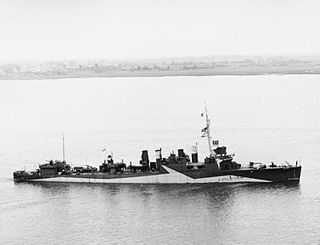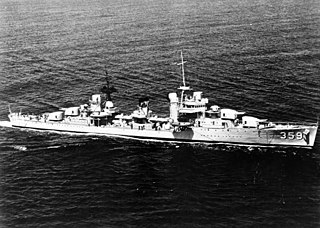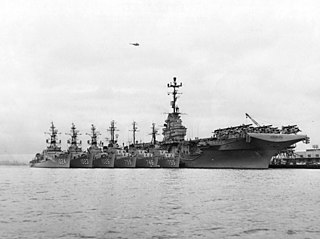
The Battle of the Atlantic, the longest continuous military campaign in World War II, ran from 1939 to the defeat of Nazi Germany in 1945, covering a major part of the naval history of World War II. At its core was the Allied naval blockade of Germany, announced the day after the declaration of war, and Germany's subsequent counter-blockade. The campaign peaked from mid-1940 through to the end of 1943.

USS Ranger (CV-4) was an interwar United States Navy aircraft carrier, the only ship of its class. As a Treaty ship, Ranger was the first U.S. vessel to be designed and built from the keel up as a carrier. She was relatively small, just 730 ft (222.5 m) long and under 15,000 long tons (15,000 t), closer in size and displacement to the first US carrier—Langley—than later ships. An island superstructure was not included in the original design, but was added after completion.

Ernest Joseph King was a fleet admiral in the United States Navy who served as Commander in Chief, United States Fleet (COMINCH) and Chief of Naval Operations (CNO) during World War II. He directed the United States Navy's operations, planning, and administration and was a member of the Joint Chiefs of Staff and Combined Chiefs of Staff and was the U.S. Navy's second-most senior officer in World War II after Fleet Admiral William D. Leahy, who served as Chief of Staff to the Commander in Chief.

The first ship named in honor of Rear Admiral Aaron Ward, USS Aaron Ward (DD-132) was a Wickes-class destroyer in service with the United States Navy. In 1940, she was transferred to the Royal Navy and renamed HMS Castleton.

The first USS Twiggs (DD–127) was a Wickes-class destroyer in the United States Navy during World War I. She was named for Major Levi Twiggs. She was later transferred to the Royal Navy, as HMS Leamington and to the Soviet Navy as Zhguchy, before returning to Britain to star in the film The Gift Horse, which depicts the St. Nazaire Raid.

USS Upshur (DD–144) was a Wickes-class destroyer in the United States Navy before and during World War II. She was the first ship named for Rear Admiral John Henry Upshur.

The second USS Buck (DD-420), a World War II-era Sims-class destroyer in the service of the United States Navy, was named after Quartermaster James Buck, a Civil War Medal of Honor recipient. It was built by Philadelphia Naval Shipyard and launched in 1939. It was a member of the convoy carrying the US 1st Provisional Marine Brigade. She served during the Second World War. It was sunk by the German submarine U-616 on 9 October 1943 off the coast of Salerno, when it was working in support of Operation Avalanche. It received 3 battle stars for its services during the Second World War.

USS Welborn C. Wood (DD-195) was a Clemson-class destroyer in the United States Navy during World War II. She served with the United States Coast Guard as USCGD Wood. She was later transferred to the Royal Navy as HMS Chesterfield.

USS Herndon (DD-198) was a Clemson-class destroyer in the United States Navy. Herndon served in the United States Coast Guard as CG-17. She was later transferred to the Royal Navy as HMS Churchill and still later to the Soviet Navy as Deyatelny.

USS Bulmer (DD-222/AG-86) was a Clemson-class destroyer in the United States Navy during World War II. It was the last warship of the Asiatic Fleet in USN commission.

USS Winslow (DD-359/AG-127) was a Porter-class destroyer in service with the United States Navy from 1937 to 1950. She was scrapped in 1959. Winslow was the longest serving by far of all U.S. destroyers commissioned during the 1930s and the last by far to go to the ship breakers.

The Somers-class destroyer was a class of five 1850-ton United States Navy destroyers based on the Porter class. They were answers to the large destroyers that the Japanese navy was building at the time, and were initially intended to be flotilla leaders. They were laid down from 1935–1936 and commissioned from 1937–1939. They were built to round-out the thirteen destroyers of 1,850 tons standard displacement allowed by the tonnage limits of the London Naval Treaty, and were originally intended to be repeat Porters. However, new high-pressure, high-temperature boilers became available, allowing the use of a single stack. This combined with weight savings allowed an increase from two quadruple center-line torpedo tube mounts to three. However, the Somers class were still over-weight and top-heavy. This was the first US destroyer class to use 600 psi (4,100 kPa) steam superheated to 850 °F (454 °C), which became standard for US warships built in the late 1930s and World War II.

USS Jouett (DD-396) was a Somers-class destroyer in the United States Navy. She was named for Rear Admiral James Edward Jouett.

USS Benson (DD-421) was the lead ship of her class of destroyers in the United States Navy during World War II. She was named for Admiral William S. Benson (1855–1932).
Convoy HX 156 was the 156th of the numbered series of World War II HX convoys of merchant ships from Halifax, Nova Scotia to Liverpool. Forty-three ships departed Halifax on 22 October 1941, and were met two days later by United States Navy Task Unit 4.1.3 consisting of Gleaves-class destroyer Niblack, Clemson-class destroyer Reuben James, Wickes-class destroyer Tarbell, and Benson-class destroyers Benson and Hilary P. Jones.

Hunter-killer Groups, also known as Convoy Support Groups, were groups of anti-submarine warships that were actively deployed to attack submarines during World War II. The advances in signals intelligence such as high-frequency direction finding, in cryptological intelligence such as Ultra, and in detection technologies such as radar and sonar/ASDIC enabled the Allied navies to form flotillas designed to actively hunt down submarines and sink them. Similar groups also existed during the Cold War. A hunter-killer group would typically be formed around an escort carrier to provide aerial reconnaissance and air cover, with a number of corvettes, destroyers, destroyer escorts, frigates, and/or United States Coast Guard Cutters armed with depth charges and Hedgehog anti-submarine mortars.

Arctic naval operations of World War II were the World War II naval operations that took place in the Arctic Ocean, and can be considered part of the Battle of the Atlantic and/or of the European Theatre of World War II.

Convoy Hi-71 (ヒ-71) was one of the World War II Hi convoys of fast tankers and troop transports from Japan to Singapore. The heavily defended convoy was specially loaded with reinforcements for defense of the Philippines, and encountered a wolfpack of United States Navy submarines in the South China Sea after being scattered by an August 1944 typhoon. Personnel losses were high because heavy seas prevented rescue of crewmen from sunken ships.

The Greenland Patrol was a United States Coast Guard operation during World War II. The patrol was formed to support the U.S. Army building aerodrome facilities in Greenland for ferrying aircraft to the British Isles, and to defend Greenland with special attention to preventing German operations in the northeast. Coast Guard cutters were assisted by aircraft and dog sled teams patrolling the Greenland coast for Axis military activities. The patrol escorted Allied shipping to and from Greenland, built navigation and communication facilities, and provided rescue and weather ship services in the area from 1941 through 1945.
World War II was the first war where naval aviation took a major part in the hostilities. Aircraft carriers were used from the start of the war in Europe looking for German merchant raiders and escorting convoys. Offensive operations began with the Norwegian campaign where British carriers supported the fighting on land.



















